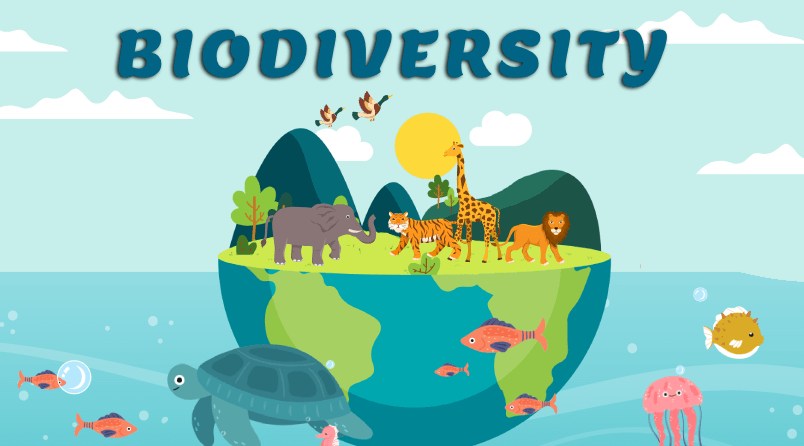Set 1 | Important Biodiversity MCQs
Important Biodiversity MCQs. Biodiversity plays a crucial role within the broader field of environment and ecology. It serves as a foundational concept for achieving success in competitive exams such as Civil Services, State exams, SSC, Railways, Banking, and more. Mastering these subjects offers a unique advantage, allowing you to gain invaluable insights into the country’s environmental legacy. With a focus on Environment, Biodiversity, and Ecology, this knowledge not only sharpens your competitive edge but also equips you to excel in these challenging exams.
| MCQs on Ecology – Objective Questions and Answers |

Q1. Biodiversity is described as – (U.P.R.O./A.R.O. (Mains) 2014)
[A] The range of different species in an environment
[B] The seasonal and daily changes in an environment
[C] The way species differ from one another
[D] The influence of physical factors on an environment
View Explanation
Correct Answer is A.
- Biodiversity refers to the variety of organisms, both plants and animals, present within an ecosystem. These species are grouped into various communities specific to a particular ecosystem.
- Biodiversity is categorized into alpha (α), beta (β), and gamma (γ) diversity, a classification introduced by Whittaker in 1960.

Q2. Biodiversity means – (U.P.P.C.S. (Pre) 2014)
[A] Diverse kinds of plants and vegetation.
[B] Diverse kinds of animals.
[C] Diverse kinds of plants and animals in a particular area.
[D] Diverse kinds of exotic plants and animals.
View Explanation
Correct Answer is C.
- Biodiversity refers to the variety of living organisms, including plants, animals, fungi, and microorganisms, that inhabit a particular ecosystem. It encompasses the diversity of species, genetic variation within those species, and the variety of ecosystems in which they live.
- Biodiversity plays a crucial role in maintaining ecosystem balance, supporting essential processes such as nutrient cycling, pollination, and climate regulation.
- It is classified into three levels: alpha diversity, which measures species richness within a specific area or ecosystem; beta diversity, which compares species diversity between ecosystems; and gamma diversity, which assesses overall species diversity across large regions or landscapes.
- This classification, first introduced by ecologist Robert Whittaker in 1960, helps to understand biodiversity patterns and the distribution of species across different habitats. Preserving biodiversity is essential for sustaining ecosystem services and promoting resilience against environmental changes.
Q3. The most significant aspect of biodiversity is: (U.P.P.C.S. (Pre) 2015)
[A] Food
[B] Drug
[C] Industrial Use
[D] Maintenance of ecosystem
View Explanation
Correct Answer is D.
- The most crucial aspect of biodiversity is its role in maintaining the balance and functioning of ecosystems. Biodiversity operates at various levels, including species diversity, the organization of species into communities, and the diversity of ecosystems themselves.
- Each level contributes to essential ecological processes such as nutrient cycling, energy flow, and ecosystem resilience, which are vital for the stability and health of natural environments. Maintaining biodiversity ensures the sustainability of these processes, supporting life on Earth.
Q4. The destruction of biodiversity is due to: (U.P.P.C.S. (Mains) 2002)
[A] The lack of natural habitats of the organism
[B] Environmental pollution
[C] Destruction of forests
[D] All the above
View Explanation
Correct Answer is D.
The primary cause of biodiversity loss is human impact on the world’s ecosystems. The major threats to biodiversity can be outlined as follows:
- Habitat alteration and destruction: The conversion of natural habitats into urban areas, agriculture, or industrial zones leads to the loss of species’ natural environments.
- Introduction of exotic species and genetically modified organisms: Non-native species and genetically modified organisms can outcompete, displace, or harm native species, disrupting local ecosystems.
- Pollution: Contamination of air, water, and soil through industrial activities, waste, and chemicals negatively affects species and their habitats.
- Climate change: Global warming and changing climate patterns alter habitats, disrupt migration patterns, and threaten species adapted to specific environmental conditions.
- Overexploitation of resources: Unsustainable harvesting of natural resources, including overfishing, deforestation, and hunting, depletes species populations and disrupts ecosystems.

Q5. Which of the following is NOT an example of in-situ conservation strategy? (U.P. P.C.S. (Pre) 2018)
[A] Biosphere reserve
[B] Botanical garden
[C] National Park
[D] Sacred groves
View Explanation
Correct Answer is B.
Examples of ex-situ conservation include:
- Seed banks: Facilities that store seeds to preserve genetic diversity and protect plant species from extinction.
- Zoological parks: Zoos where animals are maintained in controlled environments for conservation, breeding, and educational purposes.
- Botanical gardens: Places where a wide variety of plant species are cultivated and conserved for research, education, and preservation.
Examples of in-situ conservation include:
- National Parks: Protected areas established to conserve wildlife and natural habitats while allowing minimal human interference.
- Sanctuaries: Protected areas dedicated to the conservation of species in their natural habitats, with controlled human activities.
- Biosphere reserves: Large areas that integrate conservation, sustainable use of resources, and scientific research.
- Reserved Forests and Protected Forests: Forest areas with legal protection for biodiversity, where exploitation is regulated.
- Nature Reserves: Areas designated to protect specific species and ecosystems with minimal human intervention.
Q6. The main reason for the decrease in biodiversity is: (U.P.P.C.S. (Pre) 2016)
[A] Habitat pollution
[B] Introduction of exotic species
[C] Over exploitation
[D] Natural habitat destruction
View Explanation
Correct Answer is D.
- The destruction of natural habitats is a leading cause of biodiversity loss. When natural areas are transformed or degraded, it not only results in the loss of plant species but also leads to a decline in the animal species that depend on those plants for food, shelter, and survival.
- This disruption of ecosystems has cascading effects, reducing the overall biodiversity and weakening the ecological balance needed to sustain healthy environments.
Q7. Which one of the following is the most important factor responsible for the decline of biodiversity? (U.P.P.C.S (Pre) 2010)
[A] Genetic assimilation
[B] Controlling assimilation
[C] Destruction of habitat
[D] Controlling pests
View Explanation
Correct Answer is C.
- Habitat loss is one of the most significant threats to biodiversity. Examples include deforestation to make way for agriculture, filling wetlands for urban development, and constructing dams that alter natural river flows. These activities destroy ecosystems, leading to a reduction in species diversity.
- Genetic assimilation is a process in which a trait that initially appears only in response to environmental factors becomes ingrained in the organism’s genetic makeup through natural selection. Over time, this trait can be expressed even without the environmental trigger, becoming a stable part of the organism’s phenotype.
Q8. The main reason for the decrease in biodiversity is – (U.P.P.C.S. (Pre) 2015)
[A] Habitat pollution
[B] Introduction of exotic species
[C] Over-exploitation
[D] Habitat destruction
View Explanation
Correct Answer is D.
- Habitat loss poses a major threat to biodiversity. Examples include clearing forests for agriculture, filling wetlands for housing developments, and building dams that alter river systems, all of which lead to ecosystem destruction and a decline in species diversity.
- Genetic assimilation refers to the process by which a trait that originally appears only in response to specific environmental conditions becomes integrated into an organism’s genetic makeup through natural selection. Eventually, the trait is expressed even in the absence of the original environmental trigger, becoming a permanent feature of the organism’s phenotype.
Q9. Biodiversity has maximum danger from: (U.P.P.C.S. (Pre) 2017)
[A] Destruction of natural habitats and vegetation
[B] Improper agricultural operations
[C] Climate change
[D] Water pollution
View Explanation
Correct Answer is A.
Q10. Government of India in collaboration with the Norwegian Government has established a centre for Biodiversity Policy and Law at- (U.P. R.O./A.R.O. (Mains) 2017)
[A] Dehradun
[B] Chennai
[C] Shillong
[D] New Delhi
View Explanation
Correct Answer is B.
- The Government of India, in collaboration with the Norwegian Government, has established the “Centre for Biodiversity Policy and Law (CEBPOL)” within the National Biodiversity Authority (NBA) in Chennai. This initiative aims to enhance professional expertise in biodiversity policies and laws, as well as to build capacity in these areas.
Related articles:
- Set 2 | Important Biodiversity MCQs
- Set 3 | Important Biodiversity MCQs
- Set 4 | Important Biodiversity MCQs
- Set 5 | Important Biodiversity MCQs
- Set 6 | Important Biodiversity MCQs
- Set 7 | Important Biodiversity MCQs
- Set 8 | Important Biodiversity MCQs
- Set 9 | Important Biodiversity MCQs
- Set 10 | Important Biodiversity MCQs
- Set 11 | Important Biodiversity MCQs






